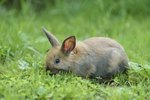Its distinct scent, symmetrical branches and widespread availability make the Norfolk pine a staple of the Christmas holiday in the United States. While many households enjoy decorating these trees as part of their winter celebration, this tradition isn't always safe for your furry family members. Exposure to pine leaves and sap can cause digestive problems in felines, as well as the potential for physical injury.
Pine Toxicity
While the compound responsible for pine toxicity in cats has not been identified, both the sap and needles are known health hazards for pets, according to the American Kennel Club Canine Health Foundation. Cats may be tempted to play with or chew the needles, especially if they are laden with flashy ornaments. Your kitty may ingest the sap while grooming if it gets stuck in his fur.
Perhaps the biggest danger lies in the basin at the bottom of the tree, where sap collects and mixes with the water. The water may contain other toxic agents along with pine sap, including:
- Bacteria and mold
- Fertilizers from cultivation
- Pesticide residue
- Chemicals applied to enhance appearance of the tree.
Tips
Restrict access to the tree's water basin with a barrier and make sure your cat has a bowl of clean water nearby to satisfy his thirst.
Pine Poisoning Symptoms
Pine trees are considered to be mildly toxic to cats, so there is little risk of a fatal reaction. It's possible that you won't notice any changes or symptoms at all if your cat only consumes a small amount of sap. However, take the risk seriously and keep your cat away from pine trees at all times.
The primary signs of pine poisoning in cats are lethargic behavior and digestive issues, including vomiting and diarrhea. More severe symptoms may occur if your cat continues to ingest the sap, or if he drinks contaminated water from the basin. The additional toxins from fertilizers and chemicals sprayed on the tree before purchase can cause various symptoms, including:
- Changes in thirst, hunger and urination frequency from kidney failure.
- Discoloration of the gums from liver damage.
- Severe digestive distress and incontinence.
- Muscle weakness.
- Drooling and labored breathing.
Emergency Care
Consult with a veterinarian if you believe your cat has ingested needles, sap or water from the tree's basin. Keep your cat away from the tree and observe him carefully for signs of poisoning. While fatal cases of pine toxicity are extremely rare, your vet may administer emetics to clear your pet's stomach or activated charcoal to absorb the toxins, according to PAWS Dog Daycare in Charlotte, Florida.
Recovery from pine poisoning generally is expected within a few hours or days with prompt medical treatment.
Related Health Hazards
Pines and other popular holiday trees also pose a mechanical threat to your pet. The stiff, pointed leaves can scratch or puncture the throat and stomach. Perforations of the digestive tract can be life-threatening. Strings and tinsel are another big threat, as they can twist your cat's intestines if swallowed. There's also a risk of injury if your cat falls while climbing through the branches, or if he pulls the whole tree down on top of himself.
References
Writer Bio
Quentin Coleman has written for various publications, including All Pet News and Safe to Work Australia. He spent more tan 10 years nursing kittens, treating sick animals and domesticating semi-feral cats for a local animal shelter. He graduated from the University of Delaware with a bachelor's degree in journalism.





